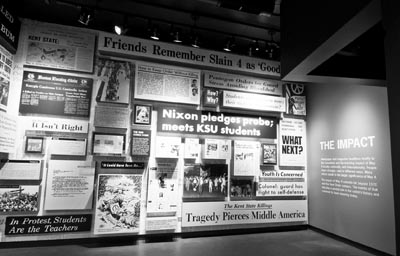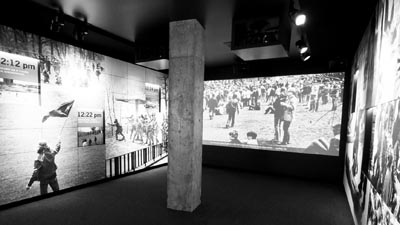 Download PDF of this full issue: v42n2.pdf (5.4 MB)
Download PDF of this full issue: v42n2.pdf (5.4 MB)From Vietnam Veterans Against the War, http://www.vvaw.org/veteran/article/?id=2140
 Download PDF of this full issue: v42n2.pdf (5.4 MB) Download PDF of this full issue: v42n2.pdf (5.4 MB) |

|
Opening October 20, 2012, the May 4 Visitors Center at Kent State University tells the story of the shootings on May 4, 1970, against the political and cultural changes of the 1960s—including the movement against the war in Vietnam. From the perspective of more than 40 years, this powerful and informative interactive experience remembers the students who lost their lives on May 4, while offering meaning for today in their loss.
In response to Richard Nixon's April 30, 1970, Cambodia announcement, protests against Nixon's broken promise to end the war erupted around the country. On Monday, May 4, four days of protest at Kent State expanded to decry the presence of the Ohio National Guard on campus. The Guard had been called into town by the city mayor and entered campus Saturday night when the university's ROTC building burned. After dispersing a rally scheduled for noon, Guardsmen unexpectedly turned 135 degrees at the top of a hill and fired down into a parking lot that held a mix of protestors, spectators, and passersby. 28 of the 76 guardsmen and officers at the top of the hill fired 67 rounds in 13 seconds, killing four Kent State students and wounding nine others.
Historians cite the Kent State shootings as a watershed moment in US history and an important turning point in the consciousness of Americans about the war. Substantial protest continued to follow in the aftermath of May 4, including the April 1971 action that had Vietnam veterans tossing their medals onto the Capitol steps, as shown in the exhibit.
Gallery 1 of the May 4 Visitors Center exhibit helps visitors understand such acts by depicting what the decade of the sixties was like. As illustrated in the exhibit, the sixties was a turbulent era of change and political and cultural divide. Through words, pictures, sound, and film, it explores three central themes of the sixties: the struggle for social justice, the generation gap, and the Vietnam War.
Gallery 2 depicts what happened on May 4 in an immersive theater experience using wall-sized iconic photos and a new film documentary displayed on a screen that also is wall sized. Visitors feel as though they are standing in the stream of history as it unfolds.
Visitors exit the close, immersive space of Gallery 2 to face a wall 27 feet wide and 12 feet high that samples the breadth and the depth of the impact of May 4 locally, nationally, and internationally. Depicted is the killing of unarmed protestors at Kent State was experienced by middle America as "the day the war came home." Its impact resounded from the president's office in the US to the prime minister's office in the USSR.
Over the past five years, scholars from Kent State University worked with humanities scholars, consultants, community leaders and students—including individuals with military experience in Vietnam—to determine the content for the May 4 Visitors Center. Members of the public and campus, local historians and community leaders contributed ideas through public forums and focus groups. Kent State professors and national experts examined exhibit content to ensure accuracy and balanced viewpoints. Reviewers for the National Endowment for the Humanities, the Ohio Humanities Council, the Ohio Preservation Office, and the Department of the Interior added positive feedback and constructive ideas.
In the days when the Kent State University May 4 Visitors Center was only a dream, we could hardly imagine being able to open its doors one day. VVAW was one of the center's earliest contributors. Many at Kent State remember the visibility of VVAW in even earlier days in the sixties and the contribution to the spirit of change VVAW made at that time. We are appreciative and honored to have had VVAW's support for more than four decades. VVAW's support helped lay the foundation for what would grow to a comprehensive fundraising initiative for the design and construction of the $1.1 million center. Recent donors include the National Endowment for the Humanities, which provided $300,000. And as an expression of Kent State's national leadership role in promoting nonviolence and democratic values, the university's 16 deans gave $667,000 through their colleges and campuses to help students and the public learn from the past to shape a better future.
The opening of the May 4 Visitors Center on the Kent State campus is part of a year-long series of events designed to educate, inform, and help people reflect on the legacy of May 4, 1970, and its meaning for today. The fall calendar includes an address by Tom Hayden at 7:00 p.m. on October 30. The formal dedication and acknowledgment of the hundreds who have helped create the May 4 Visitors Center will be held during the annual commemoration from May 3 through 5, 2013. Details will be posted at www.kent.edu/may4 and on the May 4 Visitors Center Facebook page.

|
Laura Davis is a professor of English and faculty coordinator for May 4 initiatives at Kent State University. A freshman in 1970, she was a witness to the shootings.